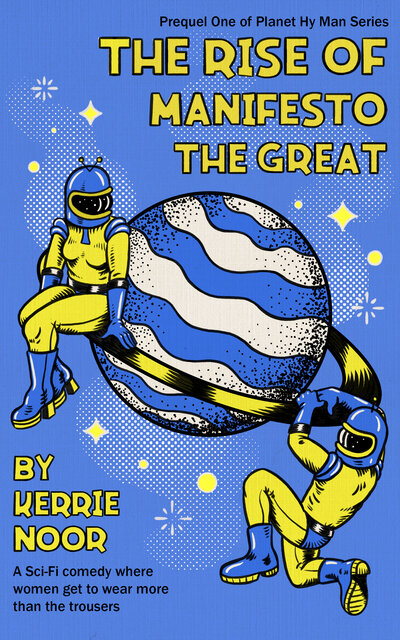Genre: Sci-Fi, Humor, Satire
Reviewer: CK
Get It On Amazon
About The Book
Manifesto the Great comes from a dynasty of leaders who treat women like breeding machines. When his father dies, he must take over as leader, but will he be able to control the women?
Planet Hy Man is a planet as pure as a baby’s belly button until a spaceship arrives. A spaceship full of celibate men and women hungry for all things ‘earthy’.
They hurl themselves into a frenzy of real meat, real air, and procreation until a leader emerges to create order, civilization, and a sewage system.
Manifesto the Great watches as his forefathers pollute the planet, treat women like they are walking wombs, and design dodgy robots until that is, it’s his turn.
Will he rise over the tidal wave of discontented women, or will he drown under a sea of underwire and estrogen?
The Rise Of Manifesto The Great is the first of three prequels to the Planet Hy Man science-fiction comedy series. If you like high-mileage heroines, fast-paced satire, and meticulously crafted universes, then you’ll love Kerrie Noor’s otherworldly farce.
The Review
The first of three prequels to Kerrie Noor’s “Rebel Without…” sci-fi comedy series, “The Rise of Manifesto The Great” delivers on its subtitle’s promise, “a sci-fi comedy where women wear more than the trousers.” And exactly how they wear those the pants among planet Hy Man’s pointedly misogynist society, Noor presents in clever, skillful manner, throughout this wild ride fueled by well-written, comedic 21st century fabulism.
In solid fabulist style, from the opening sentence, the narrative itself teaches readers how to read the book, that genre and other literary and material “norms” are being played with, that sober, tough stuff will be teased and taunted, tortured and flipped with a playful ease that inspires re-reads.
Rich with social commentary, Noor does what skilled fabulists do: examine contemporary and historic issues through estrangement, displacement, and replacement. Set on “Planet Hy Man, a small planet north of the Milky Way,” purposely “timed” to Earth’s 1830s and 1920s, readers encounter contentious real-life issues, distanced to another world rich with animals but no humans, until spacefaring colonists arrive. Three spaceships crewed with four classes of humans land on Hy Man across three separate arrivals. Each landing brings a social chaos requiring intervention by peculiar social technology: Manifestos and decrees by Leaders-by-inheritance. The novel’s leader-family begins on the first ship with “Hubby” and his mate, “Wife-ie,” along with their son “Arthur of the North” and his subsequent Settler-class sons, “James The Strong,” and “Manifesto The Great.”
The novel’s science-fiction commentary on technologies and scientific estrangements draws on our current climate crises, toxic waste, and pollution—the first tech-appearance on planet Hy Man is a waste management plant. The spaceships’ crews are more passengers than technicians in control of the vessels. “Mirrors” are versions of voyeuristic CCTV, where Victorian life on Earth functions as Hy Man’s societal entertainment media. Super hemp and soya become the fundamental food and recreational substance resources, along with interconnected social consequences. Veganism and animal rights join the fray with four-legged animals hunted and slaughtered until mechanical versions are required. These fuel social problems and political intrigue across the novel’s world-build and narrative arc.
Social chaos and consequential attempts at Order-by-Manifestos address beliefs rooted in primitive biological realities and displaced historical necessities. Noor’s use of non-terrestrial estrangement and displacement through social and mechanical technologies is driven by both named characters and aptly presented caricatures.
The latter carry fable-descriptive names like “Loud Mouth” and “LM-2.” Occupational typed characters such as “Washerwoman” and “Bin Emptier” enhance both style and story. Written in a fable-like narrative style, fueled by dry wit, and tongue-in-cheek nods to both Hy Man societal drama and our own. Noor goes-the distance tapping Shakespeare under the radar, right down to Bard-esque duos offering comic relief at moments of profoundly tense, action-packed conflict. The Leader house’s drama draws on Machiavelli’s “The Prince” and a Rasputin-like “Librarian,” subverter of all things good.However obnoxious—even offensive—a character could be, there is a complexity and laughability present, their charm and endearment are inevitable.
That facile approach to character and story reflects a savvy consciousness of class and classism essential to all the other social issues in the novel. Noor creates structural realities as a skeleton supporting the muscular, nervous, and circulatory systems of the primary “cold war of the sexes” that form the Hy Man social body. The core conflicts within sort and sift together into an unnerving replacement for Order, adding more chaos the Manifestos and declarations are supposed to resolve. Rich through-lines develop a commentary on art and technology, enterprise, and divisions of labor in service of a self-appointed elite. She elegantly narrates the ruling family’s social-political intrigue with comedic wit, allowing some unsettling sex and gender issues to become palatable and open to exploration.
The sober disturbing stuff of the Hy Man social body manifest in the very-bad-men and the noble put-upon women, complicated with moments of hapless and collisional enlightenment. Wife-ie’s solutions aboard ship and on planet Hy Man’s surface are pragmatic survival strategies that men turn into sexist chaos, unable to slip a euphemistic “family member”-swinger’s bravado. Her grandson, James The Strong, literally favors going commando beneath animal hides, along with grandiose public feats of strength, dragging spaceships through town on well-seasoned ropes. His only “admirable” qualities are his gravitational sexual power and prowess with every woman on Hy Man, and his ease of manipulation by savvier women. Women, fundamentally oppressed, cannot slip biology: their nobler aspirations stymied by very-bad-men. The real heroes are the androgynous, biologically sexless outcasts who identify as women.
These amplified sex/gender ills, so ubiquitous on planet Hy Man, tragically mirror lived experience on Earth—though some of us would hope we’re not half as terrible men or women. Men on Hy Man are little more than nasty, sometimes funny brutes manipulated by malevolently clever Machiavellian men and aspirational, ambitious women. There is much in the novel that can make a 21st century Earther, het-dude squirm, were it not for the fabulist style and gritty dry wit that estranges and displaces the tough stuff far enough from real-life so we can grapple with it.
A fan of science fiction and 21st century fabulism, especially Brit-Commonwealth humor and irascible wit, I admire the narrative Noor employs. She drives a highly entertaining ride with rich insight into contemporary and historical “big questions”—all the bread and butter stuff of speculative fiction with a slick sensibility of a capable author. The Rise of Manifesto The Great is raw fun and cleverly disturbing. It is refreshing to encounter ungenre-genre work—I read it three times, it’s that enjoyable. I’ve already grabbed the second and third prequels along with the three books in the series, and Kerrie Noor is my new favorite.
The Reviewer
CK wrangled a Creative Writing degree from an unsuspecting Californian university and authored & published numerous speculative fiction stories and a few novels, among other shenanigans. Christopher writes from overpopulated, under-watered California with a brilliant Mate and some Beasts (cute knuckleheads of felus domesticus)—there are some grown-up Offspring somewhere—“Call yer father!”


